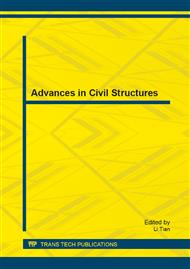p.583
p.587
p.592
p.596
p.601
p.610
p.615
p.619
p.626
Mechanical Properties of New Type Cold-Formed Steel Box-Shaped Component Welding Section Members
Abstract:
Cold-formed steel box-shaped section has the special features in both its mass center and moment center unification as double symmetry section and its outstanding advantage in moment and torsion rigidity. This paper presents a new kind of cold-formed steel box-shaped component welding sections, that is flanges opposite welding box-shaped component section DS. The mechanical properties such as buckling modes, load carrying capacity, rigidity, ductility and correlation curves of new section members which are subjected to axial compression, flexure, combined compression and bending have been analyzed by using nonlinear finite element method. The consumed steel quantities of per unit load carrying capacity between new section members and the same section dimensions of cold-formed C-section members have been compared systematically, too. Some conclusions can be drawn from above work that the DS section members have some superior properties, such as higher load carrying capacity and section modulus especially subjected to compression load, sufficient section stiffener and the sub-element local buckling hard to happen and so on. They are particularly suitable to withstand axial compressive loads, but also suitable to withstand the bending moment and bending loads. The consumed steel quantities are as almost 50% as the same dimension C-section members. The DS section members can go deep into the experimental study as to be used in the practical engineering.
Info:
Periodical:
Pages:
601-609
Citation:
Online since:
August 2013
Authors:
Price:
Сopyright:
© 2013 Trans Tech Publications Ltd. All Rights Reserved
Share:
Citation:


